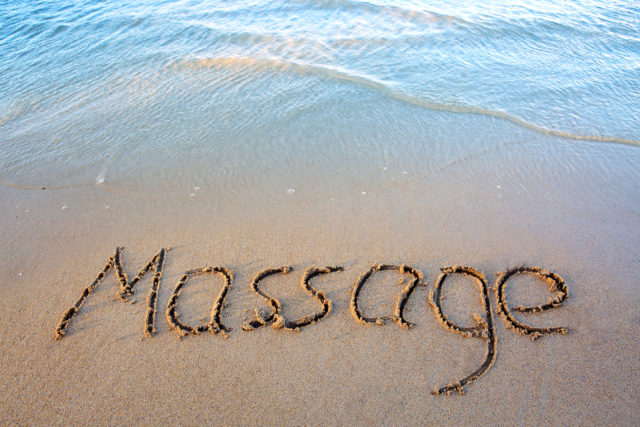 The journey of a massage therapist is one filled with purpose, fulfillment, and the opportunity to make a meaningful difference in the lives of others. For many, it’s not just a job but a calling—an invitation to engage in healing, relaxation, and the overall betterment of people’s physical and mental well-being. But what makes a career in massage therapy so satisfying? What are the elements that contribute to the high levels of job satisfaction that many massage therapists report? In this post, we’ll explore the various facets of this rewarding profession and why so many find it to be a deeply fulfilling career choice.
The journey of a massage therapist is one filled with purpose, fulfillment, and the opportunity to make a meaningful difference in the lives of others. For many, it’s not just a job but a calling—an invitation to engage in healing, relaxation, and the overall betterment of people’s physical and mental well-being. But what makes a career in massage therapy so satisfying? What are the elements that contribute to the high levels of job satisfaction that many massage therapists report? In this post, we’ll explore the various facets of this rewarding profession and why so many find it to be a deeply fulfilling career choice.
1. A Profession Rooted in Helping Others
At the core of massage therapy is the ability to help people. Whether it’s alleviating chronic pain, reducing stress, improving flexibility, or enhancing overall wellness, massage therapists are on the front lines of personal care. They get to witness the immediate and positive effects of their work, which can be incredibly rewarding. This sense of purpose—knowing that your work directly contributes to someone else’s well-being—can be a powerful driver of career satisfaction.
Massage therapists often speak of the profound impact they have on their clients’ lives. Many clients seek massage therapy as a holistic approach to managing chronic conditions, such as back pain, arthritis, or stress-related ailments. The relief they experience after a session can be transformative, both physically and emotionally. For the therapist, this transformation is not just a professional success but a personal fulfillment. Seeing a client leave the session feeling better, moving more freely, or simply wearing a relaxed smile is a daily affirmation of the therapist’s chosen path.
2. A Flexible and Personalized Career Path
One of the major appeals of massage therapy is the flexibility it offers. Massage therapists have the option to work in a variety of settings—from spas, wellness centers, and chiropractic offices to private practice and even mobile massage services. This flexibility extends to work schedules as well. Whether you prefer to work part-time, full-time, or just a few hours a week, you can often tailor your career to fit your lifestyle. For those who value work-life balance, this flexibility is a significant factor in job satisfaction.
Flexibility is particularly important for those who might be balancing multiple responsibilities, such as family, education, or other career interests. The ability to adjust work hours to accommodate personal needs is a key factor in reducing burnout and maintaining long-term satisfaction in the profession. Moreover, this flexibility allows therapists to explore different work environments and client demographics, giving them the freedom to find the niche that best suits their interests and skills.
Additionally, the rise of digital platforms and mobile applications has opened new avenues for massage therapists to offer their services. Mobile massage services, where therapists travel to clients’ homes or workplaces, have become increasingly popular. This not only provides convenience for clients but also allows therapists to expand their client base and work in diverse settings. The ability to create a personalized career path that aligns with individual goals and preferences is a significant advantage of this profession.
3. Opportunities for Specialization and Growth
Massage therapy is a field rich with opportunities for specialization. Therapists can choose to focus on specific modalities such as deep tissue massage, sports massage, prenatal massage, or reflexology. These specializations not only allow therapists to deepen their expertise but also to cater to specific client needs, which can be both financially rewarding and professionally fulfilling.
The pursuit of specialization often leads to a deeper sense of mastery and accomplishment. As therapists gain expertise in a particular modality, they often find themselves sought after by clients who need specialized care. For example, sports massage therapists may work with athletes to prevent injuries and enhance performance, while prenatal massage therapists support pregnant clients through the physical changes of pregnancy. This ability to make a significant difference in specific client populations adds a layer of fulfillment that goes beyond general practice.
Furthermore, the continuous learning aspect of massage therapy contributes to career satisfaction. Many therapists find joy in advancing their skills and knowledge through ongoing education and certification in new techniques. This commitment to growth keeps the career dynamic and interesting, preventing burnout and fostering a sense of accomplishment. Professional organizations like the American Massage Therapy Association (AMTA) and the National Certification Board for Therapeutic Massage & Bodywork (NCBTMB) offer resources for continuing education, helping therapists stay at the forefront of the field.
4. A Positive Work Environment
Unlike many other professions, massage therapy typically takes place in calm, serene environments designed to promote relaxation and healing. The ambiance of a massage therapy room—soft lighting, soothing music, and a general sense of peace—can make for a pleasant work environment. For those who value a tranquil and stress-free workplace, this is an enormous benefit that enhances overall job satisfaction.
The importance of a positive work environment cannot be overstated, especially in a profession where the therapist’s own well-being directly impacts the quality of care provided. A well-designed massage space not only helps clients relax but also contributes to the therapist’s sense of calm and focus. Many therapists find that the peaceful environment of their workspaces helps them maintain a balanced and centered state of mind, which is essential for providing effective therapy.
Moreover, the work environment in massage therapy often fosters a sense of community and connection among colleagues. Whether working in a spa, wellness center, or clinic, therapists often develop strong bonds with their coworkers, sharing knowledge and experiences that enrich their practice. This sense of camaraderie can significantly enhance job satisfaction, making the workplace a source of support and inspiration.
5. Building Strong Client Relationships
Massage therapy is inherently personal. Therapists often develop strong, trusting relationships with their clients. Over time, these relationships can become a source of joy and fulfillment as therapists witness their clients’ progress and improvements in health and well-being. The gratitude and appreciation expressed by clients can be a powerful motivator, reinforcing the therapist’s sense of purpose and satisfaction in their work.
The client-therapist relationship is built on trust, communication, and mutual respect. As therapists work with clients over time, they often become attuned to their clients’ physical and emotional needs, allowing for more personalized and effective care. This deep understanding not only enhances the therapeutic experience for the client but also enriches the therapist’s sense of connection and purpose.
In many cases, these relationships extend beyond the therapy room. Clients often express their gratitude through positive feedback, referrals, and even long-term loyalty. This ongoing relationship provides therapists with a steady stream of clients, contributing to both financial stability and professional fulfillment. The emotional rewards of knowing that your work has a lasting impact on someone’s life are immense and are often cited by therapists as one of the most satisfying aspects of their career.
6. Physical and Emotional Well-Being
It’s not just the clients who benefit from massage therapy—therapists themselves often experience physical and emotional rewards. The nature of the work requires therapists to maintain good physical health, including strength and flexibility. Additionally, the meditative and rhythmic nature of giving a massage can be a calming experience, helping therapists manage their own stress and maintain emotional balance.
Massage therapy is a physically demanding profession, but one that promotes health and wellness. Many therapists find that the physical nature of the job keeps them active and mindful of their own well-being. Regular exercise, proper body mechanics, and self-care practices are essential for sustaining a long and healthy career in massage therapy. This focus on health not only benefits the therapist but also enhances the quality of care provided to clients.
Emotionally, massage therapy can be a deeply rewarding practice. The repetitive, rhythmic movements of massage often create a meditative state for the therapist, allowing them to remain present and focused. This meditative quality can be soothing, helping therapists maintain emotional equilibrium even in the face of life’s stresses. The act of giving a massage can also be a form of emotional release, as therapists channel positive energy into their work, which can be both healing and rejuvenating for themselves.
7. Financial Independence and Career Stability
Massage therapy can offer a level of financial independence and career stability that is appealing to many. With the right business strategies and client base, therapists can build a lucrative practice. Moreover, the demand for skilled massage therapists is steady, contributing to job security. Whether working independently or within an established business, the financial aspect of massage therapy can be a significant contributor to career satisfaction.
The financial potential of a massage therapy career is often influenced by several factors, including location, specialization, and experience. Therapists who establish a strong client base, particularly in areas with high demand for wellness services, can achieve significant financial success. Additionally, those who specialize in high-demand modalities, such as sports massage or medical massage, may command higher rates, further enhancing their earning potential.
Beyond individual practice, massage therapists may also find opportunities in management, education, or product development within the wellness industry. These avenues provide additional career stability and the potential for financial growth. The ability to achieve financial independence while doing work that is personally fulfilling is a powerful motivator for many therapists.
8. The Joy of Continuous Learning and Adaptation
The world of health and wellness is always evolving, and massage therapists who are passionate about their work tend to embrace this evolution. Whether it’s learning new techniques, staying updated on the latest research, or exploring complementary fields like aromatherapy or yoga, the ability to continuously learn and adapt is both a challenge and a source of satisfaction for many therapists.
Continuous learning is a hallmark of the massage therapy profession. As new research emerges and techniques evolve, therapists are encouraged to expand their knowledge and skills. This commitment to lifelong learning not only keeps the practice fresh and engaging but also enhances the quality of care provided to clients. Many therapists find joy in mastering new techniques and integrating them into their practice, offering clients a broader range of services.
Furthermore, the integration of complementary practices, such as aromatherapy, energy work, or yoga, can enrich the therapeutic experience for both therapist and client. By expanding their skill set, therapists can offer a more holistic approach to wellness, addressing the physical, emotional, and spiritual needs of their clients. This holistic perspective is deeply satisfying for many therapists, who see their role as facilitators of overall well-being rather than just physical health.
9. Contribution to a Growing Wellness Movement
In today’s world, there’s a growing awareness of the importance of self-care and holistic wellness. Massage therapists are at the forefront of this movement, providing services that are increasingly recognized as essential to maintaining physical and mental health. Being part of a larger wellness community and contributing to a societal shift towards better health practices can provide a deep sense of pride and satisfaction.
The global wellness movement has brought increased recognition to the role of massage therapy in promoting health and well-being. As more people seek alternatives to conventional medicine, the demand for holistic therapies, including massage, has grown significantly. Massage therapists are now seen as vital contributors to preventive health care, offering services that not only address physical pain but also enhance mental and emotional resilience.
Being part of this broader wellness community can be incredibly fulfilling for massage therapists. The ability to contribute to a societal shift towards healthier living, and to educate clients about the benefits of regular massage, adds a layer of purpose to the profession. Many therapists take pride in being advocates for wellness, knowing that their work is part of a larger movement towards holistic health.
10. Personal Fulfillment and Lifestyle Compatibility
Ultimately, many massage therapists find that their career aligns with their personal values and lifestyle. Whether it’s the desire to help others, the appreciation for holistic health practices, or the need for a career that allows for creativity and personal expression, massage therapy offers a unique blend of professional and personal fulfillment. For those who choose this path, the rewards are often much greater than just a paycheck—they are about living a life in harmony with one’s values and passions.
For many therapists, massage therapy is more than just a job; it’s a way of life. The principles of holistic health, mindfulness, and compassion that guide their work often extend into their personal lives. This alignment between personal values and professional practice is a key factor in the high levels of job satisfaction reported by many therapists. The ability to live a life that is in harmony with one’s beliefs and passions is a rare and valuable gift, and massage therapy offers that opportunity.
Moreover, the creative aspects of massage therapy—such as designing personalized treatment plans or integrating different modalities—allow therapists to express their individuality within their practice. This creative freedom, combined with the ability to make a tangible difference in people’s lives, makes massage therapy a deeply fulfilling career for those who are passionate about health and wellness.
Conclusion: A Fulfilling Path Awaits
For those considering a career in massage therapy, the potential for job satisfaction is immense. From the opportunity to help others to the flexibility and personal growth the career offers, there are numerous reasons why massage therapists find their work fulfilling. It’s a career that not only provides financial stability but also nourishes the soul, offering a unique blend of professional success and personal fulfillment.
Whether you are drawn to the healing aspect, the positive work environment, or the continuous opportunities for learning, massage therapy is a career that offers a deep sense of purpose and satisfaction. If you’re looking for a profession that is as rewarding as it is impactful, massage therapy might just be the perfect fit for you.
—————————————————————————————————————-
Sources:
- American Massage Therapy Association (AMTA). “2023 Massage Profession Research Report.”
- Bureau of Labor Statistics (BLS). “Occupational Outlook Handbook – Massage Therapists.”
- Journal of Bodywork and Movement Therapies. (2019). “Specialization in Massage Therapy.”
- Massage Magazine. “The Role of Work Environment in Massage Therapy Job Satisfaction.”
- International Journal of Therapeutic Massage and Bodywork. (2018). “The Client-Therapist Relationship and Job Satisfaction.”
- Complementary Therapies in Clinical Practice. (2017). “The Meditative Effects of Massage Therapy.”
- Journal of Continuing Education in the Health Professions. (2021). “The Importance of Ongoing Education for Healthcare Professionals.”
- Global Wellness Institute. (2023). “The Wellness Economy: The Role of Massage Therapy.”
- Holistic Nursing Practice. (2020). “Personal Values and Career Satisfaction in Massage Therapy.”

The Promising Job Outlook for Massage Therapy: A Career Path on the Rise
4o

Animal Massage Therapy
 In today’s fast-paced world, stress and tension affect not only humans but also our beloved animal companions. To address their physical and emotional well-being, the field of animal massage therapy has emerged as a rewarding and fulfilling career option. If you have a passion for animals and an interest in holistic healing practices, becoming a massage therapist for animals can open up a world of opportunities. In this article, we will explore the educational and licensing requirements specifically in Washington State, as well as the diverse opportunities available in this growing profession.
In today’s fast-paced world, stress and tension affect not only humans but also our beloved animal companions. To address their physical and emotional well-being, the field of animal massage therapy has emerged as a rewarding and fulfilling career option. If you have a passion for animals and an interest in holistic healing practices, becoming a massage therapist for animals can open up a world of opportunities. In this article, we will explore the educational and licensing requirements specifically in Washington State, as well as the diverse opportunities available in this growing profession.
Why Animal Massage Therapy? Just like humans, animals can experience a range of physical and emotional issues that can be alleviated through massage therapy. Animal massage therapists play a vital role in promoting relaxation, reducing pain and inflammation, enhancing circulation, improving mobility, and aiding in overall recovery for animals in need. This non-invasive, drug-free, and gentle approach can have profound benefits for animals of all species, ages, and conditions.
Educational Requirements: To embark on a career as an animal massage therapist in Washington State, it is essential to acquire a solid educational foundation. While specific requirements may vary, completing a comprehensive training program is a common prerequisite. Several schools and institutions across the state offer specialized programs in animal massage therapy. These programs typically cover topics such as anatomy and physiology, massage techniques, animal behavior, ethics, and business practices.
Animal Massage Therapist Applicants in Washington State must meet one or more of the following:
- To practice massage on large animals, the 300 hours of instruction must be related to the performance of animal massage on large animals.
- To practice massage on small animals, the 300 hours of instruction must be related to the performance of animal massage on small animals.
In addition to formal education, gaining hands-on experience is crucial for honing your skills and understanding the intricacies of working with different animals. Volunteering at animal shelters, rescue centers, or veterinary clinics can provide valuable opportunities to observe and practice under the guidance of experienced professionals.
Licensing and Certification: In Washington State, massage therapy for animals is regulated by the Washington State Department of Health, ensuring the highest standards of care and professionalism. To legally practice as an animal massage therapist, you must obtain a license. The requirements for licensure typically include completing an approved training program, accumulating a specified number of hours of supervised practice, and passing a licensing exam.
Animal Massage Therapist Applicants in Washington State must pass one or more of the following exams:
- To practice massage on large animals, successfully complete the National Certification Examination for Equine Massage.
- To practice massage on small animals, successfully complete the National Certification Examination for Canine massage.
Moreover, obtaining certification from recognized organizations can enhance your credibility and open doors to more opportunities. Organizations like the National Board of Certification for Animal Acupressure and Massage (NBCAAM) offer certification programs that validate your knowledge, skills, and commitment to ethical practices.
Opportunities in Animal Massage Therapy: Once you have obtained the necessary education, licensing, and certification, a range of exciting career paths awaits you in animal massage therapy:
- Private Practice: Many animal massage therapists choose to establish their private practices, providing individualized care to clients and their animal companions. This option allows you to set your own schedule, tailor your services to specific needs, and build strong relationships with clients and their pets.
- Veterinary Clinics and Hospitals: Collaborating with veterinarians and veterinary professionals can be a rewarding way to integrate massage therapy into an existing practice. Working in a clinical setting allows you to provide adjunctive care to animals undergoing surgery, rehabilitation, or suffering from chronic conditions.
- Animal Rehabilitation Centers: These specialized facilities focus on helping animals recover from injuries, surgeries, or physical disabilities. Animal massage therapists play an integral role in the rehabilitation process, working alongside veterinarians, physical therapists, and other professionals.
- Animal Rescue Organizations: Animal rescue centers often encounter animals with traumatic experiences or special needs. Massage therapy can provide comfort, reduce anxiety, and promote trust in these animals, increasing their chances of finding forever homes.
- Equine Massage: Horses, in particular, benefit greatly from massage therapy. Opportunities exist to work with horse owners, trainers, and equestrian facilities, providing therapeutic care to these magnificent animals.
Becoming a massage therapist for animals in Washington State offers a fulfilling career path for those passionate about holistic healing and the well-being of animals. By completing the necessary education, obtaining a license, and seeking certification, you can unlock a wide range of opportunities to make a positive impact on the lives of animals. Whether you choose to establish your own practice, collaborate with veterinary professionals, or work in specialized settings, your skills as an animal massage therapist can bring comfort, healing, and joy to our furry, feathered, and scaled friends. Embrace this rewarding profession and embark on a journey to enhance the health and happiness of animals in your community.

Marketing a Massage Therapy Practice.
 Massage therapy is a growing industry that is becoming increasingly popular as people seek natural and holistic solutions to their health and wellness needs. However, with so many massage therapists out there, it can be difficult to stand out from the competition and attract new clients. Effective marketing techniques can help you to promote your massage therapy practice and grow your business. Here are some effective techniques to market a massage therapy practice.
Massage therapy is a growing industry that is becoming increasingly popular as people seek natural and holistic solutions to their health and wellness needs. However, with so many massage therapists out there, it can be difficult to stand out from the competition and attract new clients. Effective marketing techniques can help you to promote your massage therapy practice and grow your business. Here are some effective techniques to market a massage therapy practice.
- Define your target market: The first step in marketing your massage therapy practice is to define your target market. Who are your ideal clients? What are their needs, interests, and pain points? By understanding your target market, you can tailor your marketing messages and strategies to reach them more effectively.
- Build a professional website: A professional website is an essential tool for any massage therapist. Your website should be easy to navigate, visually appealing, and provide all the necessary information about your services, pricing, and contact details. You can also use your website to showcase your expertise by including a blog, testimonials from satisfied clients, and before-and-after photos.
- Utilize social media: Social media is a powerful tool for marketing a massage therapy practice. Platforms like Facebook, Instagram, and Twitter allow you to connect with potential clients and promote your services. Share updates, special offers, and photos of your work to engage with your followers and attract new clients.
- Offer referral discounts: Encourage your current clients to refer their friends and family by offering them a discount on their next appointment. Referrals are one of the most effective ways to attract new clients, and offering a discount is a great way to incentivize your clients to refer others.
- Create a loyalty program: A loyalty program is a great way to encourage repeat business from your existing clients. Offer incentives for clients who book multiple appointments, such as a free massage after a certain number of appointments.
- Attend local events: Attending local events such as health fairs, community events, and expos can be a great way to promote your massage therapy practice. Set up a booth or table to showcase your services and offer discounts to attendees.
- Offer gift certificates: Gift certificates are a great way to attract new clients and encourage repeat business from existing clients. Offer gift certificates for special occasions like birthdays and holidays, and make it easy for clients to purchase them online.
- Write a blog: A blog is a great way to establish yourself as an expert in your field and attract potential clients. Write about topics related to massage therapy, health, and wellness, and share your posts on social media and other platforms to reach a wider audience.
- Use email marketing: Collect email addresses from your clients and send them regular newsletters with updates, special offers, and information about your services. Email marketing can be a highly effective way to stay in touch with your clients and encourage repeat business.
- Network with other professionals: Networking with other professionals in the health and wellness industry, such as chiropractors and personal trainers, can be a great way to generate referrals and attract new clients.
- Host a workshop: Offer a workshop or class related to massage therapy or wellness. This can be a great way to attract new clients and establish yourself as an expert in your field.
- Offer free consultations: Offer free consultations to potential clients to help them understand your services and how they can benefit from them. This can be a great way to build trust and establish a relationship with new clients.
- Partner with local businesses: Partner with local businesses, such as gyms and health food stores, to offer discounts to their customers. This can be a great way to reach a wider audience and attract new clients.
- Use online directories: List your business on online directories, such as Yelp and Google My Business, to increase your online visibility. Make sure to include all the necessary information, such as your services, pricing, and contact details, and encourage satisfied clients to leave positive reviews.
- Offer mobile services: Offering mobile massage services can be a great way to attract clients who are unable to travel to your location. You can offer massages in clients’ homes or workplaces, providing convenience and flexibility.
- Create video content: Video content is becoming increasingly popular on social media, and can be a highly effective way to showcase your services and attract new clients. Consider creating short videos demonstrating different massage techniques or sharing information about the benefits of massage therapy.
- Participate in online forums: Participate in online forums and communities related to massage therapy and wellness. Offer helpful advice and information, and include a link to your website in your signature to attract potential clients.
- Create a referral network: Partner with other professionals in the health and wellness industry to create a referral network. This can be a great way to generate referrals and attract new clients who are interested in a holistic approach to health and wellness.
- Offer package deals: Offer package deals for clients who book multiple appointments or refer friends and family. This can be a great way to incentivize repeat business and generate new clients through referrals.
- Host a social media contest: Host a social media contest, such as a giveaway or photo contest, to engage with your followers and attract new clients. Encourage participants to share your contest with their friends and family for maximum exposure.
In conclusion, marketing a massage therapy practice requires a combination of traditional and digital marketing techniques. By defining your target market, building a professional website, utilizing social media, offering referral discounts and loyalty programs, attending local events, and partnering with other professionals in the industry, you can attract new clients and grow your business. It’s important to experiment with different marketing strategies and track your results to determine what works best for your massage therapy practice. With a solid marketing plan in place, you can build a successful and thriving massage therapy business.
For more information about beginning your massage therapy career contact our massage school admissions department.

Massage Therapy in Healthcare
 Massage Therapy: An Effective Complementary Treatment in Healthcare
Massage Therapy: An Effective Complementary Treatment in Healthcare
In recent years, the use of complementary and alternative medicine (CAM) in healthcare has increased in popularity. One such practice that has gained significant attention is massage therapy. Massage therapy is a hands-on technique that involves the manipulation of soft tissues in the body to promote relaxation, reduce stress, and alleviate pain. While once considered a luxury, massage therapy is now recognized as a viable complementary treatment in healthcare.
Massage therapy has been shown to have numerous benefits, both physical and psychological. Physically, massage therapy can help improve circulation, reduce muscle tension, and improve joint mobility. It can also aid in the healing process of injuries by increasing the flow of nutrients and oxygen to affected areas. Psychologically, massage therapy has been found to reduce anxiety, depression, and improve overall mood. It can also improve sleep quality and decrease symptoms of PTSD.
Massage therapy has been used as a complementary treatment for various health conditions, including chronic pain, fibromyalgia, arthritis, cancer-related fatigue, and more. In fact, massage therapy has been shown to be as effective as other CAM modalities, such as acupuncture and chiropractic, in treating chronic pain conditions. Additionally, massage therapy has been found to reduce the need for prescription pain medications, which can have harmful side effects.
Massage therapy is also being increasingly used in hospital settings. Studies have shown that massage therapy can help improve patient outcomes by reducing pain and anxiety levels, improving sleep quality, and reducing the length of hospital stays. In addition, massage therapy can provide healthcare professionals with a non-invasive, non-pharmacological treatment option to use in conjunction with other medical interventions.
In conclusion, massage therapy has become a valuable complementary treatment option in healthcare. Its benefits range from physical to psychological, and its use has been found to be effective in treating various health conditions. With the growing body of evidence supporting its use, massage therapy should be considered as a viable treatment option in healthcare settings. If you are experiencing any health concerns, consider talking to a healthcare professional about the benefits of massage therapy for your specific needs.
Contact us today to learn more about massage therapy and our massage program options.

Importance of Self-care as a Massage Therapist
 As a massage therapist, you spend your days helping others relax, de-stress, and ease their physical pain. However, in order to be an effective and healthy massage therapist, it’s important to prioritize your own self-care.
As a massage therapist, you spend your days helping others relax, de-stress, and ease their physical pain. However, in order to be an effective and healthy massage therapist, it’s important to prioritize your own self-care.
Self-care is not a luxury or indulgence; it’s an essential part of your job. Taking care of yourself physically, mentally, and emotionally will not only benefit you, but also your clients. Here are some reasons why self-care is so important for massage therapists:
- Preventing Burnout: Massage therapy can be physically demanding and emotionally draining. Without proper self-care, you may experience burnout, which can lead to exhaustion, apathy, and even physical illness. Taking breaks, getting enough sleep, and engaging in stress-relieving activities can help prevent burnout.
- Maintaining Physical Health: As a massage therapist, your body is your tool. If you don’t take care of it, you risk injury or chronic pain. Regular exercise, stretching, and maintaining good posture can help keep your body strong and healthy.
- Reducing Stress: Stress is a common issue for massage therapists, who may carry their clients’ emotions and physical tension with them. Engaging in activities that help you relax, such as meditation or yoga, can help you manage stress and improve your overall well-being.
- Enhancing Emotional Resilience: In addition to physical demands, massage therapy can also be emotionally taxing. You may encounter clients with difficult emotional issues, or simply feel drained by the constant emotional energy required for your work. Engaging in self-care activities such as journaling or talking to a therapist can help you build emotional resilience and stay balanced.
- Modeling Healthy Behaviors: As a healthcare provider, you are a role model for your clients. If you prioritize self-care and demonstrate healthy behaviors, your clients are more likely to do the same. This can lead to better health outcomes for both you and your clients.
So, what does self-care look like for a massage therapist? Here are some ideas:
- Schedule Regular Breaks: Take time between clients to stretch, rest, or engage in a relaxing activity.
- Maintain a Healthy Lifestyle: Exercise regularly, eat nutritious foods, and get enough sleep.
- Engage in Stress-Relieving Activities: Meditate, practice yoga, or take a relaxing bath.
- Seek Support: Talk to a therapist, join a support group, or find a mentor to help you manage the emotional demands of your work.
- Practice Self-Compassion: Remember that taking care of yourself is not selfish; it’s necessary. Treat yourself with kindness and understanding.
In conclusion, self-care is an essential part of being a successful and healthy massage therapist. By prioritizing your own well-being, you not only benefit yourself but also your clients. So, take the time to care for yourself – you deserve it!
Learn more about becoming a massage therapist and our massage school today!

Seattle Massage Therapy Career

Currently, there are around 12,000 massage therapists working throughout the state of Washington to help the more than 7 million residents of the state find relief from the pain or discomfort associated with injuries, anxiety, and stress. According to the U.S. Bureau of Labor Statistics (BLS), the average annual salary for massage therapist in Washington is $62,520, making it one of the highest-paying states for massage therapists across the country. The cities with the highest demand for massage therapists in the Evergreen State include, in no particular order, Seattle, Spokane, Tacoma, Olympia, and Kennewick. Read on to learn about the current career outlook for massage therapist in Seattle and Washington State.
Demand and Career Outlook for Massage Therapists in Washington
According to the BLS, the state of Washington has the fourth highest demand for massage therapists across the U.S, and consistently posts high employment figures for massage therapists. In fact, the BLS projects the demand for massage therapists in the Evergreen State to grow by more than 40% over the next decade, leading to a shortage of massage therapists throughout the Evergreen State. Additionally, it could cause wages for massage therapists to rise, making the state and its cities, including Seattle, even more attractive for massage therapists.
Career Opportunities in Seattle
As mentioned earlier, Seattle is one of the best cities for massage therapist, not only in Washington State, but also across the entire country. This is because of several reasons. For starters, Seattle is a great place to set up a freelance massage therapy operation. For example, you can set up a mobile massage therapy operation, allowing you to make home and office visits. Secondly, if you decide to join the ranks of employed massage therapists in Seattle, Seattle offers numerous job opportunities for massage therapists. Some of these opportunities include:
• in-home aid and other personal care services career opportunities
• being the massage therapist in a team of health practitioners
• recreation and amusement facilities including spas and high-end hotels
• health facilities including long-term rehabilitation care facilities and hospitals
• working as a massage therapists for a sports team, such as the Seattle Mariners or Seattle Seahawks
Washington Massage Therapy Licensure Requirements
To work legally as massage therapist in Washington and Seattle, you must be licensed by the state’s department of health. The licensure requirements include, among others, completing 500 hours or more from a state-approved massage therapy program as well as taking and passing a national massage licensing exam.
Conclusion
The state of Washington is a great place for massage therapists looking to start and grow their careers, with the BLS projecting the demand for massage therapist in the state to grow by more than 40% over the next decade, potentially translating to higher wages. Some of the highest-paying cities for massage therapist in the Evergreen State include Seattle, Tacoma, Olympia, and Kennewick.
To learn more about the career outlook as a massage therapist contact our Seattle Massage School Campus
Our sister massage school Seattle Clinical Massage School can also offer additional information about attending massage therapy school in Seattle.

Massage & Carpal Tunnel
 Massage therapy is an effect treatment for carpal tunnel syndrome. Carpal tunnel syndrome is a condition caused by a pinched median nerve in the wrist. It’s associated with pain, tingling, numbness, or weakness in the hand and wrist. The carpal tunnel is a narrow canal in the wrist. The bottom and sides of the tunnel are formed by small bones called carpal bones. The top of the tunnel is a strong band of transverse carpal ligament, which holds the all components together.
Massage therapy is an effect treatment for carpal tunnel syndrome. Carpal tunnel syndrome is a condition caused by a pinched median nerve in the wrist. It’s associated with pain, tingling, numbness, or weakness in the hand and wrist. The carpal tunnel is a narrow canal in the wrist. The bottom and sides of the tunnel are formed by small bones called carpal bones. The top of the tunnel is a strong band of transverse carpal ligament, which holds the all components together.
Inside the tunnel are the median nerve and tendons. Tendons are rope-like structures that connect bones in the hand to muscles in the forearm. They also allow the thumb and fingers to bend. The median nerve runs down the arm and forearm and passes through the carpal tunnel into the palm of the hand. It provides sensation to the fingers (except the little finger). It also adds strength to some small muscles at the base of the thumb and index finger.
When the ligament thickens or tendons swell, the space in the tunnel decreases and the median nerve becomes compressed, exerting excessive pressure on the median nerve.
Symptoms of Carpal Tunnel Syndrome
Carpal tunnel syndrome symptoms include:
- Tingling, burning, or itching in the palm and fingers, especially the thumb, middle, and index fingers
- Occasional shock-like sensation that moves up into the fingers
- Pain and tingling traveling up the forearm toward the shoulder
- A swollen feeling in the fingers
- Decreased feeling in the fingertips
- Occasional hand weakness and loss of coordination
- Weakness and clumsiness in the hand, which may make it difficult to use the hand for small tasks such as writing, or buttoning a shirt
- Dropping objects due to numbness, weakness, or loss of proprioception
Symptoms of carpal tunnel syndrome begin suddenly or gradually- without a specific injury. In fact, many people find that symptoms come and go at first, and usually affected by excessive use of the hand. As the condition worsens and the pressure on the nerve becomes greater, symptoms may become more frequent or may persist for longer periods of time.
It’s common for people to experience nighttime symptoms because many sleep with their wrists bent. In the morning, a person may wake up with tingling or numbness in their hands. They may not notice the problem at all during the day, but symptoms often flare up when holding something with the wrist bent, such as when reading a book, using a phone, or driving. Many patients find that moving or shaking the hands can relieve the symptoms in the early stages of the condition.
Causes of Carpal Tunnel Syndrome
Carpal tunnel syndrome is often caused by a combination of factors that irritate or squeeze the median nerve. Possible contributing factors include:
- Activities that involve highly repetitive wrist or finger motions, like typing, farming, or knitting. Repetitive motions may aggravate the tendons in the wrist, causing swelling that exerts pressure on the nerve. This usually happens when the hands are lower than the wrists
- Trauma or injury to the wrist, such as sprain or fracture. This may break one or more of the carpal bones, cause swelling, or deform the small bones in the wrist
- Arthritis-related diseases, especially if there is swelling of the wrist joint, tendons, and tissues in the carpal tunnel
- Work that involves heavy use of the wrist
- Mechanical problems in the wrist joint
- Hormonal changes and fluid retention caused by pregnancy or menopause
- Repeated use of vibrating hand tools or instruments that require forceful gripping and put pressure at the base of the palm
- Heredity
- Health conditions such as diabetes, amyloidosis, kidney failure, lymphedema, menopause, an underactive thyroid gland, or an overactive pituitary gland
Massage Therapy for Carpal Tunnel Syndrome
Massage therapy is a non-invasive and effective treatment for carpal tunnel syndrome. It helps relieve the symptoms of carpal tunnel syndrome by reducing swelling in the muscles caused by damage or overextension in the work environment. It also works by breaking down scar tissue, and softening and lengthening muscles and fascia of the shoulder, neck, elbow, wrist, hand, forearm, and upper arm.
During a massage session, the therapist will use deep tissue work to stimulate trigger points, release adhesions, and reduce the tension in the soft tissues of the arm, shoulder, hand, and wrist. This involves bringing the arm and shoulder out of internal rotation or incorporating myofascial cupping to reduce muscle tension.
By massaging and stretching tendons in the arm and wrist, a massage therapist can help restore full flexibility of the arm and reduce the pressure the tendons are putting on the median nerve. This in turn reduces the inflammation, pain, and numbness associated with carpal tunnel syndrome.
The number of massage sessions it takes for a patient with carpal tunnel syndrome to find relief will vary depending on how severe the problem is. Most clients experience some level of relief after the first session but for others, it may take three to five sessions or more to get long-term results.
Learn Advanced Massage Therapy Techniques from the Experts
While massage therapy is effective in treating carpal tunnel syndrome, it must be done right to get the expected results. If you’d like to expand your knowledge and skills in massage therapy, enroll in one of Seattle’s best massage therapy schools to learn therapeutic massage therapy protocols. You’ll learn massage theories and practices, anatomy and physiology, pathology, kinesiology, and much more. This will equip you with the skills you’ll need to provide care for individuals who’ve been affected by carpal tunnel syndrome and other similar ailments.
Another option for massage therapy schools in Seattle is our sister school Seattle Clinical Massage School
Contact us today to speak with one of our enrollment specialists.

Pediatric Massage Therapy for Scoliosis

Scoliosis is a condition that millions of Americans are familiar with. You may have already worked with patients who suffer from pain, discomfort, and stiffness due to scoliosis. This condition is particularly detrimental to children, who may struggle with weak muscles, back pain, and fatigue from long periods of standing upright.
Luckily, massage therapy can be used to help treat scoliosis in children. A pediatric massage involves manipulating soft tissues with the aim of relieving tension and improving blood flow to affected regions. When done correctly, the symptoms of scoliosis in children can be significantly reduced.
Understanding Scoliosis in children
Scoliosis is a condition where the spinal cord curvature is increased more than usual. The spine typically has a mild curve as it runs across your back. However, patients with scoliosis have a spinal cord that resembles a C or an S shape.
Congenital scoliosis (in children) typically occurs during birth and affects children as they continue to grow. The severity of this condition will vary from one patient to another. Some spinal curvatures are barely noticeable, while others can even cause a deformity in the spine.
Some risk factors of scoliosis include birth defects, infections, cerebral palsy, or genetic disorders such as Down Syndrome. Adding pediatric massage therapy skills to your current knowledge base will help you provide adequate relief to scoliosis patients.
Symptoms of Scoliosis
Scoliosis in children manifests itself in many different ways. It can begin to develop in the womb due to the incorrect division of vertebrae, or vertebrae that don’t fully grow during early stages. Diagnosis may be done soon after birth- or even later on when the child is 10-15 years old.
Some of the most common symptoms include:
Chronic back pain
An incorrectly tilted spine and pelvis
Fatigue from standing upright
Uneven shoulders
Benefits of Massage therapy
Pediatric massage therapy is a useful technique that can treat scoliosis in children. For example, effleurage massage techniques target the soft tissues and warm them up for adjustment. Through repeated strokes along the length of a child’s spinal cord, the muscles can relax and ease pain, stiffness, or tension.
Massage therapy also uses a combination of lubricants to soften the muscles and increase blood circulation to affected areas. Children with scoliosis can enjoy significant relief from symptoms and live a healthy life with timely massage therapy sessions.
Massage therapy techniques you can learn in massage school
If you wish to advance your knowledge and skills in massage therapy for scoliosis, attending massage school is an excellent way to get started. With these advanced skills under your belt, you’ll be able to provide timely pediatric massage therapy to children who’ve been affected by this condition.

Massage Therapist: A Career That Travels
 When it comes to a massage therapy career, the possibilities are endless. Massage therapists are able to work on cruises, in hospitals, in chiropractic centers, and even in airports. If you are someone who loves to travel, you may be wondering how you can incorporate your massage therapy career, and your love of traveling into one incredible life.
When it comes to a massage therapy career, the possibilities are endless. Massage therapists are able to work on cruises, in hospitals, in chiropractic centers, and even in airports. If you are someone who loves to travel, you may be wondering how you can incorporate your massage therapy career, and your love of traveling into one incredible life.
As a massage therapist, the world is your oyster. Not only can you help others relax and rehabilitate, you can also enjoy the exciting world of traveling as a massage therapist yourself. If you would like to find out how you can marry your two loves of travel and massage, check out some of the ways you can make your dream life a reality.
If the open sea is calling you, you might consider a massage therapy career aboard a luxury cruise liner. Along with helping vacationers relax and unwind, you can take in the beauty of some of the world’s most beautiful tropical destinations. Imagine yourself giving a world class massage to a couple who has just been married on day one, and then you could find yourself enjoying a beverage on a white sandy beach, overlooking the ocean on day two. This could be your every day life as a massage therapist, working on a cruise. Consider a massage therapy career and explore the possibilities yourself.
If you love traveling, massage therapy, and sports, you may consider starting your massage therapy career at an athletic training facility. You could be a massage therapist to one of your favorite athletes. You could travel from one stadium to another, providing relief and comfort to an athlete. If you want to work as a massage therapist in the Olympic field, you can make your dream a reality Many Olympians travel with their massage therapists to help them through grueling training sessions and competitions. While your client is busy working toward that gold metal, you may find yourself exploring the sites in China, South America, Canada, and more! This can be your reality with a massage therapy career.
If you are someone who prefers to be their own boss, you can choose where you would like to work. With the right marketing, you can open your services to various jobs, students, religious groups, and more. You can travel all over the country, and even the world, and offer world class massage therapy.
Do you love spas and resorts? If so, you might want to start your massage therapy career at a 5-star resort and spa. You could be just the person who helps an overworked executive begin to relax during their spa getaway. On your days off, you may find yourself looking at historical landmarks in Europe, or relaxing with a margarita on a beautiful beach in Mexico.
A massage therapy career can satisfy all areas of your life. If you are looking to incorporate massage therapy, and your love of traveling, into an exciting career, train to become a licensed massage therapist today. Your massage therapy career awaits.






